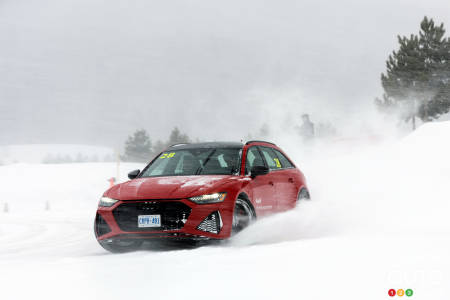
• We drove several Audi models to test the company's mechanical and electronic all-wheel drive systems in winter conditions.
• The quattro system gains in effectiveness with electrification… but something is lost in the process.
• The amount of parameter-setting possible allows drivers to tailor their car to their preferences.
Notre-Dame-de-la-Merci, QC - Electrification involves more than just a transition from gasoline- to battery-powered engines. It also opens the door to rethinking systems like all-wheel drive.
Across the industry, there are now many effective AWD systems, but the same ones always rise to the top. There’s just no substitute for experience and expertise in a field.
Audi's quattro system is one of those that inevitably comes up in discussions of the best AWD systems.
It’s a technology we’re familiar with, having tested it on many of the brand's vehicles. Its applications are numerous. I can remember a discussion with one of the engineers assigned to its development, who explained that there were 120 quattro configurations across the range. ONE HUNDRED AND TWENTY!
That was in 2012.
A little over a decade later, the group's all-wheel drive has evolved and now, with electrification, it's evolving as well so it can maintain its effectiveness, or even be improved.
So is the system actually as efficient as before. More so? Or is the existing mechanical AWD system so sophisticated that it cannot be matched?
One way to find out was to participate in an Audi winter driving program at the Circuit de Mécaglisse in Notre-Dame-de-la-Merci, north of Montreal in Quebec. And that’s what we did.
See also: Porsche Ice Experience 2023: Taming Canadian Winter Conditions, 101
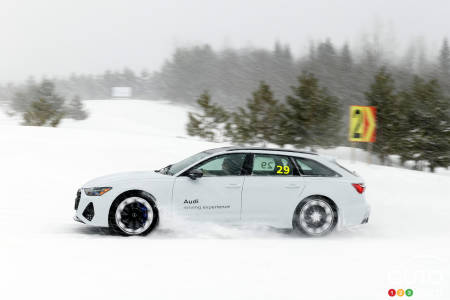
Various exercises awaited us behind the wheel of three distinct Audi models: the Q4 e-tron SUV, the RS e-tron GT (with its 590-hp electric motor and electronic all-wheel drive) and the RS 6 Avant (591 hp gasoline engine and mechanical AWD). In the latter two cases, we switched regularly between models to compare the ways in which the systems work.
The exercises
One of these had us doing laps on a relatively square track, on which we are asked to make the car’s end dance, via some proper throttle management. The objective was to position the car’s nose at the entrance of the corners so that it would act as a pivot for taking those corners.
We had two sessions at the wheel of the RS e-tron GT, two more at the wheel of the RS 6 Avant.
A few things made themselves apparent. The first is the RS e-tron GT's significantly lower centre of gravity, due to the batteries sitting under the floor of the vehicle. Even though we knew about this beforehand, it was still striking out on the course. And really that’s because the overall weight of the EV is also greater, and yet you feel less weight transfer.
Specifications of Audi RS Avant
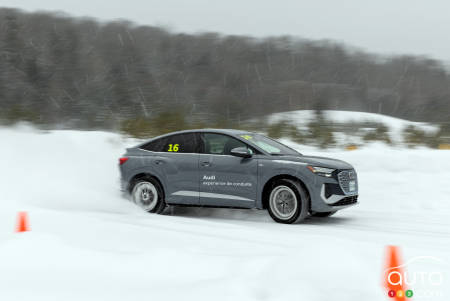
With the RS 6 Avant, we were on more familiar ground and could feel the weight transfer. In principle, more feel makes it easier to control a car to get the result you want. However, since the weight movements are greater, it takes more dexterity. The rear end, for example, will get away from you more readily. It was also more work to maintain the same angle throughout a corner in a controlled skid with this car.
With the RS e-tron GT, the lack of those familiar sensations means there’s an adjustment period. On the other hand, power is delivered in a more linear fashion, making it easier and faster to find the perfect amount of pressure on the throttle to make the rear end dance while maintaining the same angle throughout a skidded corner.
As a result, it was easier to control our skids with the electric model's all-wheel drive. Of course, there are other factors at play, such as the (knobby) tire sets that were different between the two models, as well as the weight and configuration of the two cars.
Our verdict was that the electronic all-wheel drive of the electric model is no match for the mechanical one.
Specifications sheet of Audi Q4 e-tron Sportback
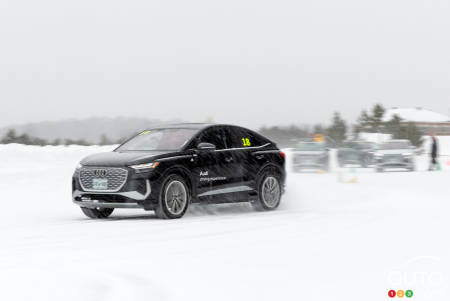
The four rings, on a ring
This was further confirmed during a second test on a circular course; here the task was to make big donuts, in controlled skidding. The technique is basic. Simply throw the stern out with the throttle and keep the pressure on so that the stern is constantly askew, as you circle around a central point.
Easier said than done, of course. Again, with both models, it was easier to accomplish the task with the electric car. Once I found the right pressure on the throttle, there was less modulation to do. The more-even weight distribution makes it less likely that the car will stall, as with the RS 6 Avant.
To sum it up as simply as possible, more time behind the wheel would have been needed to really master the mechanical system during such a manoeuvre.
Not that the difference between the AWD systems is huge; it’s just mastering the EV’s one comes more quickly.
It was certainly interesting and educational as an exercise; now if only the RS e-tron GT produced the sound of the RS 6 Avant...
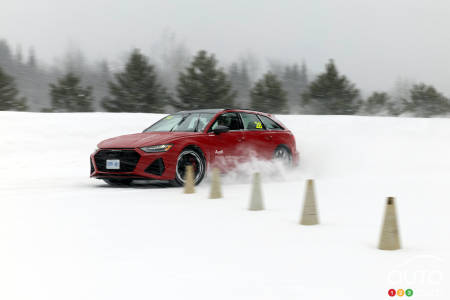
Q4 e-tron
With this electric model, a different kind of course awaited us. The start was on a flat surface where we were instructed to do a slalom exercise between cones. This was followed by a ride on the Mécaglisse road circuit. The idea was to do several runs, changing the Audi Drive Select settings each time.
There was nothing mind-blowing in this exercise, other than the actual effectiveness of the safety features. Yes, mind-blowing.
For example, with the array of aids in place, I tried a few times to get the Q4 to skid, to no avail. As soon as the rear end bugs out a little too much or you get a little too aggressive with the steering wheel, the vehicle brings you to order. A wheel locks up here, power is cut off there, whatever it takes to keep you on the right track.
That’s great of course, but more fun for us on this snow-filled day was to turn off the stability control and switch to Sport mode. Faster responses, more responsive steering, and most importantly, much later intervention of the stability control, so you can have fun behind the wheel. You can also turn everything off for even more fun.
In fact, the array of modes available means you can really adapt the settings to your driving style. That's the thing to remember: there are settings for everyone's preferences and abilities.
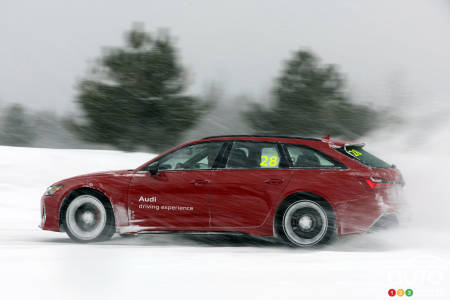
Re-learning to drive
As touched on above, what's always striking about these new electric SUVs is their lower centre of gravity. This translates, of course, into greater stability on the road. However, you have to respect the model's greater weight.
And as with the RS e-tron GT, the fact that the all-wheel drive is electronically managed means the vehicle is quicker to act when power needs to be transferred from a wheel that’s slipping to one that has grip.
We didn't get into the technical details with Audi at the event, but basically what you need to know is that the possibilities are endless with all-wheel drive in an electric model. As long as it’s equipped with the right programming, all the power could be sent to a single wheel if necessary, for example.
With mechanical systems, we're mostly talking about front to rear, and then left to right with the vectoring systems. The possibilities are immense, but not as infinite.
The final word
What's clear is that Audi's electronic all-wheel drive system doesn't lose any of its effectiveness with the switch to an electric powertrain. On the contrary, it's more effective than ever. There are some adjustments to be made by the driver, but nothing major.
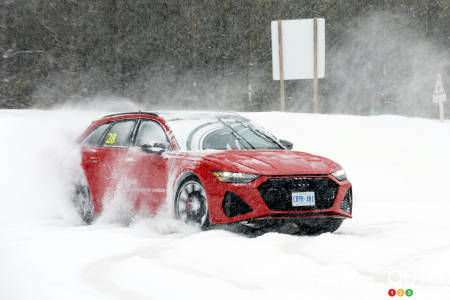
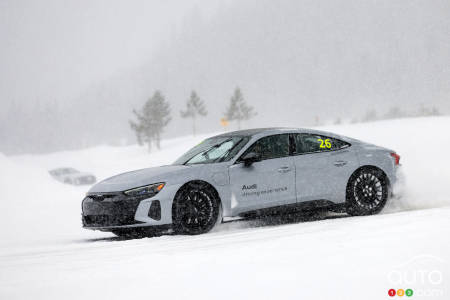
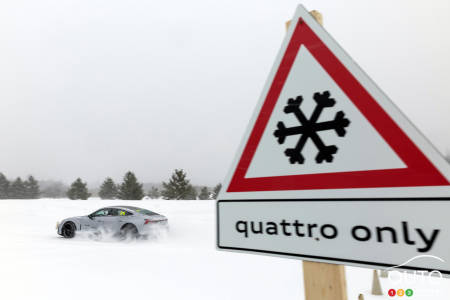


fr.jpg?scaledown=450)
